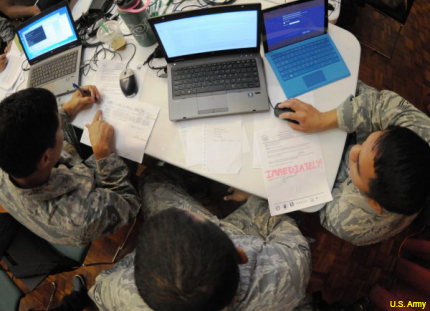National Guard making headway in nationwide cyber force
The Guard will activate 13 additional cyber units spread throughout 23 states by fiscal year 2019.

A cyber protection unit with the Hawaii Air National Guard conducts operations during training exercise in June.
The chief of the National Guard Bureau, Army Gen. Frank Grass, has announced that the National Guard will activate 13 additional cyber units across 23 states by the end of fiscal 2019.
“Our goal for cyber defense is to train, equip and provide highly-skilled forces responsive to the needs of the nation,” Grass said. “Working with the Army and Air Force, our cyber squadrons and teams will provide trained and ready soldiers and airmen to support requirements established by the services and U.S. Cyber Command.”
Bringing the Guard and Reserve into the cyber mission has been a goal of the Pentagon.
“There’s a great untapped, not yet fully tapped resource … which is our Guard and Reserve” that will help the Defense Department utilize “the best technology embedded in our military – defending [the network] so that others can’t disrupt it or exploit it, using cyber offensively as necessary and required,” Secretary of Defense Ashton Carter told lawmakers earlier this year.
“Throughout the course of this strategy, DoD will draw on the National Guard and Reserve Components as a resource for expertise and to foster creative solutions to cybersecurity problems,” the DOD Cyber Strategy, released in April, said. “The Reserve Component offers a unique capability for supporting each of DoD’s missions, including for engaging the defense industrial base and the commercial sector. It represents DoD’s critical surge capacity for cyber responders.”
As part of this effort, seven Army Guard cyber protection teams will be activated in Alabama, Arkansas, Colorado, Illinois, Kentucky, Louisiana, Minnesota, Mississippi, Missouri, Nebraska, New Jersey, New York, North Dakota, South Dakota, Tennessee, Texas, Utah, and Wisconsin. Cyber protection teams were previously activated in California, Georgia, Indiana, Maryland, Michigan and Ohio.
The Air Guard will also activate four new cyber operations squadrons in Idaho, Michigan, Texas and Virginia along with a cyber Information Surveillance Reconnaissance squadron in California and a cyber intelligence, surveillance and reconnaissance group in Massachusetts.
Grass told lawmakers in the spring that there would be 11 new cyber teams stood up in the subsequent months. The goal for the Guard’s cyber contributions would be to offer capabilities in each of the 10 Federal Emergency Management districts. Eventually, Grass said, he wants this capability to expand to every state that can support it, noting this is his commitment to governors.
Air Force Col. Timothy Lunderman, director of joint cyber operations at the National Guard Bureau, said that placing cyber capabilities within each FEMA region “ties into the Guard's mission to respond to large-scale emergencies and disasters at home.”
The Guard serves a two-pronged mission, providing units to states under the authority of a state’s governor and units ready to defend the nation. Part of the difficulty in standing up more cyber forces within the Guard is the age old issue of federalism. Grass told lawmakers that they could provide the Guard with necessary authorities – meaning clarification of state versus federal authority – to expand nationwide.
Head of U.S. Cyber Command Adm. Michael Rogers echoed this sentiment in congressional testimony in October, saying one of the challenges of the cyber force is how units will be organized under the U.S. Code going forward, with regard to the distinctions between Title 10, which governs active duty military operations, and Title 32, which covers the National Guard.
“The Army National Guard has laid computer network defensive teams into every state…Between the Army Guard and the Air Guard there is a level of cyber protection capability in each state,” said Air Force Col. Kelly Hughes, chief of the Space and Cyber Warfare Operations Division at the Air National Guard Readiness Center. “We can do this mission from anywhere…We don't have to physically relocate to do it. As long as we have the connectivity, we can operate from home station.”




